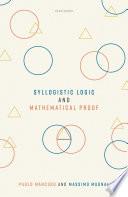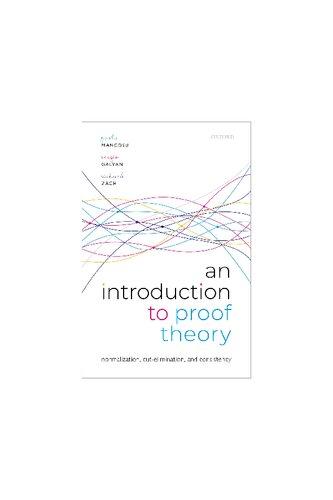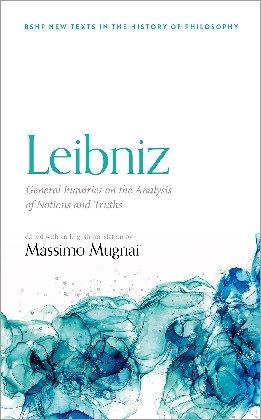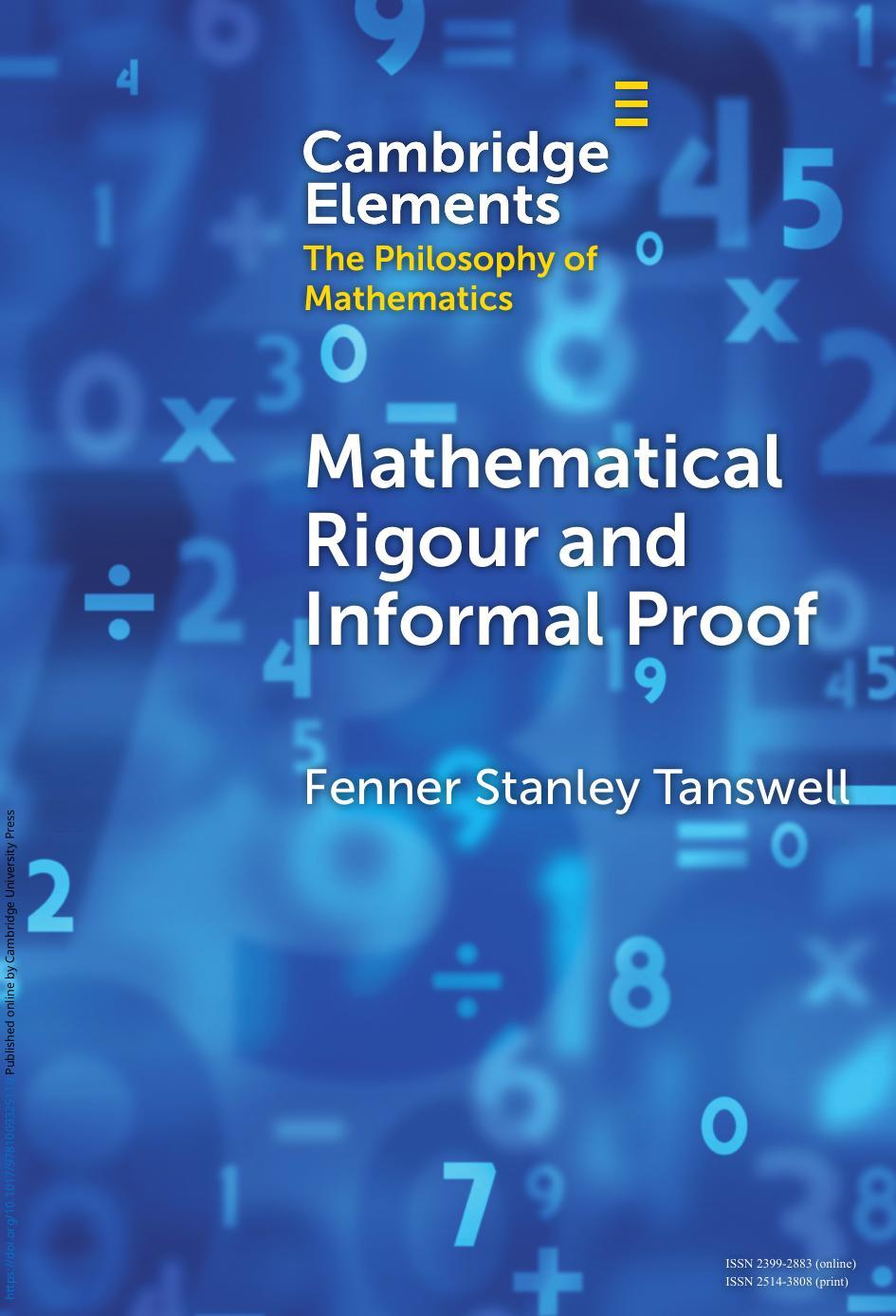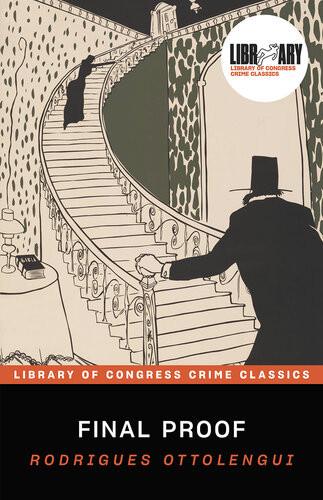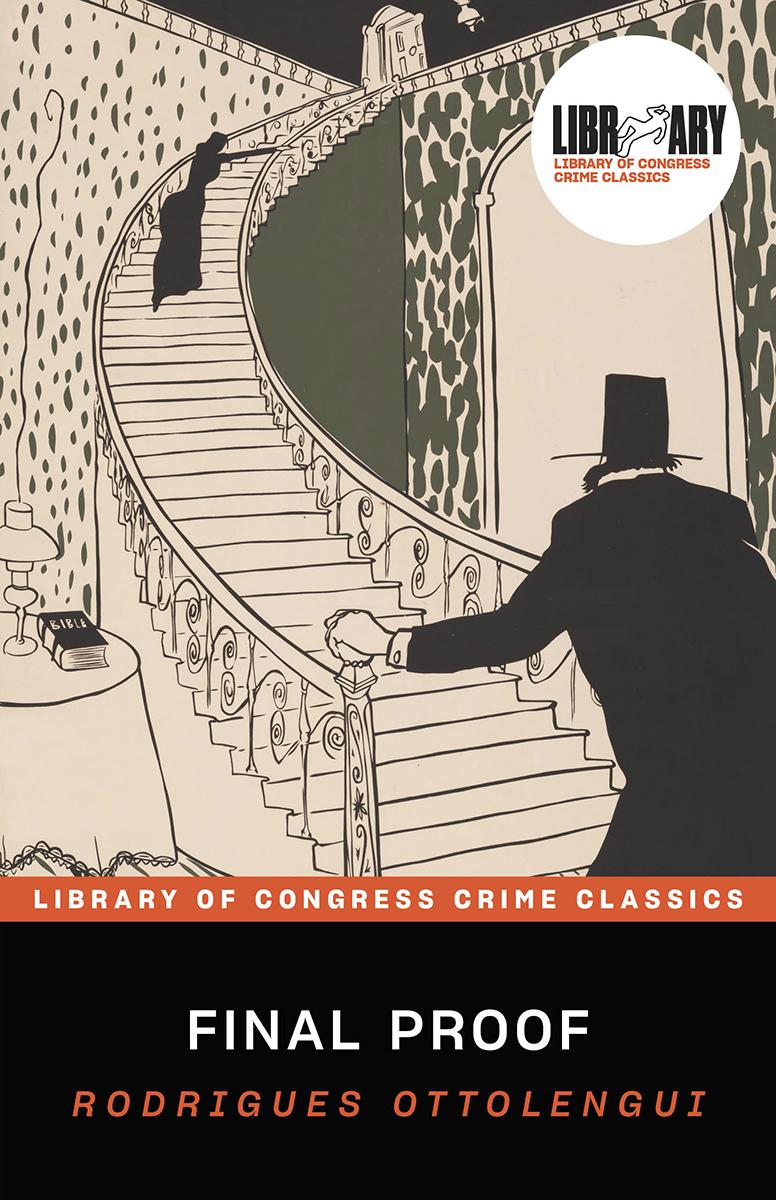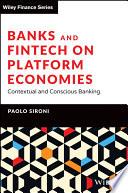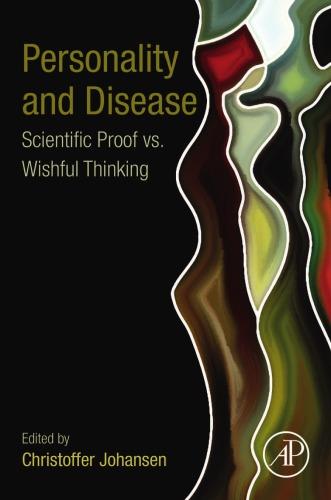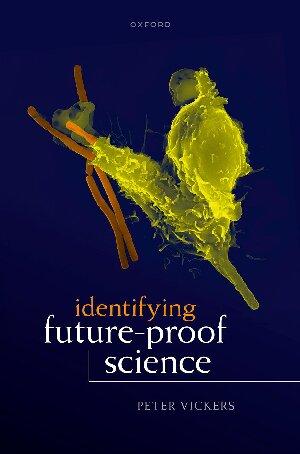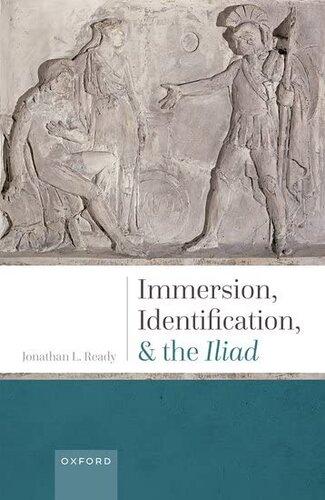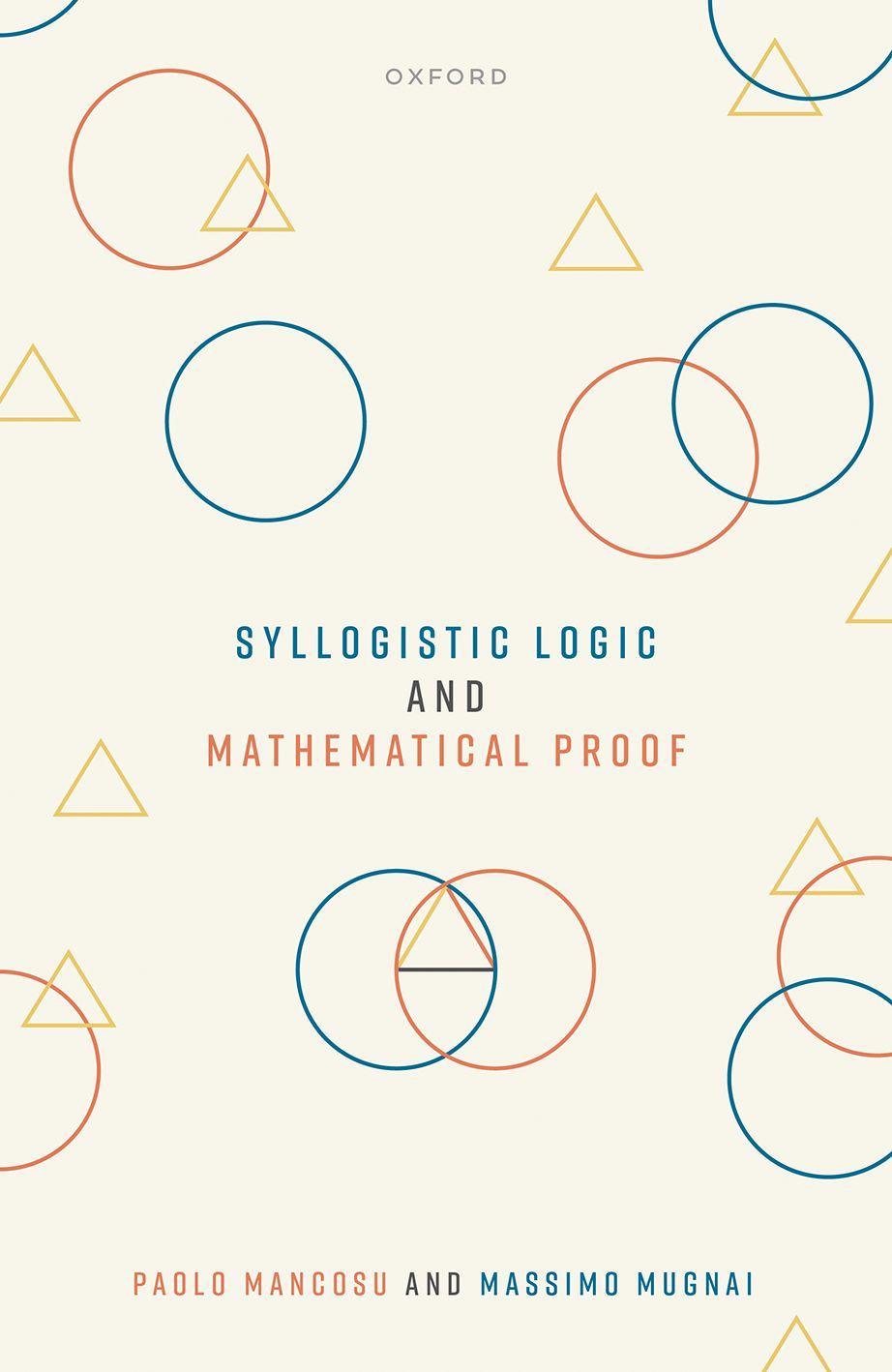Mancosu Visit to download the full and correct content document: https://ebookmass.com/product/syllogistic-logic-and-mathematical-proof-prof-paolo-m ugnai-mancosu-prof-massimo/
More products digital (pdf, epub, mobi) instant download maybe you interests ...
An Introduction to Proof Theory: Normalization, CutElimination, and Consistency Proofs 1st Edition Paolo Mancosu
https://ebookmass.com/product/an-introduction-to-proof-theorynormalization-cut-elimination-and-consistency-proofs-1st-editionpaolo-mancosu/
Leibniz: General Inquiries on the Analysis of Notions and Truths Massimo Mugnai
https://ebookmass.com/product/leibniz-general-inquiries-on-theanalysis-of-notions-and-truths-massimo-mugnai/
Mathematical Rigour and Informal Proof 1st Edition Fenner Stanley Tanswell
https://ebookmass.com/product/mathematical-rigour-and-informalproof-1st-edition-fenner-stanley-tanswell/
Final Proof Rodrigues Ottolengui
https://ebookmass.com/product/final-proof-rodrigues-ottolengui-2/
https://ebookmass.com/product/final-proof-rodrigues-ottolengui/
Banks and Fintech on Platform Economies Paolo Sironi https://ebookmass.com/product/banks-and-fintech-on-platformeconomies-paolo-sironi/
Personality and Disease: Scientific Proof vs. Wishful Thinking Johansen https://ebookmass.com/product/personality-and-disease-scientificproof-vs-wishful-thinking-johansen/
Identifying Future-Proof Science Peter Vickers https://ebookmass.com/product/identifying-future-proof-sciencepeter-vickers/
Immersion, Identification, and the Iliad Prof Jonathan L. Ready
https://ebookmass.com/product/immersion-identification-and-theiliad-prof-jonathan-l-ready/
SyllogisticLogicandMathematicalProof SyllogisticLogicand MathematicalProof PAOLOMANCOSUAND MASSIMOMUGNAI GreatClarendonStreet,Oxford,OX26DP, UnitedKingdom
OxfordUniversityPressisadepartmentoftheUniversityofOxford. ItfurtherstheUniversity’sobjectiveofexcellenceinresearch,scholarship, andeducationbypublishingworldwide.Oxfordisaregisteredtrademarkof OxfordUniversityPressintheUKandincertainothercountries ©PaoloMancosuandMassimoMugnai2023
Themoralrightsoftheauthorshavebeenasserted Allrightsreserved.Nopartofthispublicationmaybereproduced,storedin aretrievalsystem,ortransmitted,inanyformorbyanymeans,withoutthe priorpermissioninwritingofOxfordUniversityPress,orasexpresslypermitted bylaw,bylicenceorundertermsagreedwiththeappropriatereprographics rightsorganization.Enquiriesconcerningreproductionoutsidethescopeofthe aboveshouldbesenttotheRightsDepartment,OxfordUniversityPress,atthe addressabove
Youmustnotcirculatethisworkinanyotherform andyoumustimposethissameconditiononanyacquirer
PublishedintheUnitedStatesofAmericabyOxfordUniversityPress 198MadisonAvenue,NewYork,NY10016,UnitedStatesofAmerica BritishLibraryCataloguinginPublicationData Dataavailable
LibraryofCongressControlNumber:2023933211
ISBN978–0–19–887692–2 DOI:10.1093/oso/9780198876922.001.0001
PrintedandboundintheUKby ClaysLtd,ElcografS.p.A.
LinkstothirdpartywebsitesareprovidedbyOxfordingoodfaithand forinformationonly.Oxforddisclaimsanyresponsibilityforthematerials containedinanythirdpartywebsitereferencedinthiswork.
Contents Acknowledgments vii
Introduction1
1.AristotelianSyllogismandMathematicsinAntiquityand theMedievalPeriod7
2.ExtensionsoftheSyllogisminMedievalLogic17
2.1ObliqueTermsandRelationalSentencesinLateMedieval Logic:JohnBuridan,WilliamofOckham,andAlbertofSaxony17
2.2ExpositorySyllogism:IdentityandSingularTerms27
3.SyllogisticandMathematics:TheCaseofPiccolomini33
3.1Piccolomini’sSyllogisticReconstructionofEuclid ’ s Elements I.136
3.2ACriticalAnalysisofPiccolomini’sReconstruction45
4.ObliquitiesandMathematicsintheSeventeenthand EighteenthCenturies:FromJungiustoWolff51
4.1JohannesVagetius(1633–1691)57
4.2GottfriedWilhelmLeibniz(1646–1714)64
4.3JuanCaramuelLobkowitz(1606–1682)72
4.4GerolamoSaccheri(1667–1733)78
4.5AFirstConclusion80
5.TheExtentofSyllogisticReasoning:FromRüdigertoWolff83
5.1AndreasRüdiger(1673–1731)andHisSchoolonOblique Inferences83
5.2ChristianWolffonObliqueInferences89
5.3Mathematics,Philosophy,andSyllogisticInferencesin Wolff,Rüdiger,Müller,Hoffmann,andCrusius92
5.3.1Wolff:EveryMathematicalDemonstrationIsaChain ofSyllogisms92
5.3.2RüdigerandHisSchoolontheNon-SyllogisticNature ofMathematics98
5.3.2.1AndreasRüdigerontheNon-SyllogisticNature ofMathematics99
5.3.2.2SyllogismandMathematicalReasoningin Müller,Hoffmann,andCrusius113
5.3.2.3Appendix:Note(d)inRüdiger’ s DeSensu VerietFalsi (1722)118
6.LambertandKant125
6.1JohannHeinrichLambert(1728–1777)andtheTreatment ofRelationsinHisLogicalCalculus125
6.2KantandTraditionalLogic128
6.3KantonSyllogisticProofsandMathematics137
7.BernardBolzanoonNon-SyllogisticReasoning163
8.ThomasReid,WilliamHamilton,andAugustusDeMorgan177 Conclusion195
References 209
IndexofNames 223
Acknowledgments Whilewritingthisbookwehaveincurredmanydebts.Wehavedecidedto onlylistinalphabeticalorderthenamesofthosefriendsandcolleagueswho havedirectlycontributedwiththeircommentstoourtext.Weareconfident thateventhoughwedonotlistindividuallytheirspecificcontributions,they knowhowmuchwearegratefultoeachoneofthem.ThankstoFrancesco Ademollo,LanierAnderson,PaolaBasso,MichaelBeeson,WolfgangCarl, VincenzoDeRisi,DanieldiLiscia,AlessandroGiordani,OrnaHarari, DesmondHogan,EberhardKnobloch,MariaRosaMassa,Richard McKirahan,BernardoMota,JohnMumma,MarcoPanza,FrancescoPaoli, CarlPosy,DavidRabouin,StephenRead,RoshdiRashed,PaulRusnock,Boaz FaradaySchuman,Sun-JooShin,RiccardoStrobino,PaulThom,Justin Vlasits,andRichardZach.
WearealsogratefultotwoanonymousreviewersforOxfordUniversity Pressforconstructivecriticismsthathaveimprovedourtext.Manythanks alsotooureditor,PeterMomtchiloff,forhavingsupportedourprojectfrom thestartandforhavingseenitthroughpublication.
Weknowthatmathematicianscarenomoreforlogicthanlogiciansfor mathematics.Thetwoeyesofexactsciencesaremathematicsandlogic: themathematicalsectputsoutthelogicaleye,thelogicalsectputsout themathematicaleye;eachbelievingthatitseesbetterwithoneeye thanwithtwo.Theconsequencesareludicrous.
AugustusDeMorgan TheAthenaeum,July18,1868
Introduction Inthisvolume,weattempttoreconstructthevicissitudesofaconvictionthat forcenturiesprevailedamonglogiciansandphilosophersinWesternculture. ItwastheconvictionthatalltheoremsofEuclid’ s Elements and,morein general,allmathematicaltheoremscanbeprovenbymeansofthetraditional Aristoteliansyllogism.
AsHenryMendellhasshown,Aristotleadoptedatwofoldattitudetoward thesyllogism:ontheonehand,hehadaquiteliberalideaofwhatasyllogistic inferenceis,attemptingtomodifyandtoadaptittoinferencesthatdonot fit itsform,while,ontheotherhand,heclaimedthatanykindofmathematical theoremcanbeprovenbymeansofasyllogismin Barbara.¹Otherwisesaid, Aristotleassumedtobe ‘syllogisms’ inferencesthatdonothavethecanonical formofasyllogismbut,atthesametime,hestatedthateveryvaliddemonstrationultimatelyrestsonthe ‘perfect’ first figuresyllogisms.
This ‘duplicity’ ofAristotle’sattitudetowardsyllogismismirroredbythe historyoflogicintheWesterntradition:mostlogiciansandphilosophersuntil thesecondhalfofthenineteenthcenturyheldthatthesyllogismof Aristotelianoriginwasthemaintoolfordemonstratingmathematicaltheorems;toperformtheirproofs,however,theyemployedcomplexarguments thatdonothaveacanonical ‘Aristotelian’ syllogisticform.Asyllogismmay appearatsomesteporotherofthedemonstration,butingeneralthislatter cannotbeconsidered ‘syllogistic’ inthetraditional,Aristoteliansense.
Onlyaverysmallnumberofauthorswereawareofthissituation,andthey reactedintwodifferentways:someofthemsimplyconsideredthesyllogismas inadequatetoprovemathematicaltheorems,whereasothersproposedto expandtheclassicalAristoteliansyllogismaddingrelationsandrelational termstoit.
Inthesecondhalfofthenineteenthcentury,AugustusDeMorgansubordinatedthetraditionalsyllogistictoalogicofrelationsthathehadbegunto develop.SinceDeMorgan,thesyllogism,thankstoCharlesSandersPeirceand GottlobFrege,lostsomeofitspeculiarappealamonglogiciansand ¹Mendell(1998). SyllogisticLogicandMathematicalProof.PaoloMancosuandMassimoMugnai,OxfordUniversityPress. ©PaoloMancosuandMassimoMugnai2023.DOI:10.1093/oso/9780198876922.003.0001
philosophersandbecameasmallpartofamoregeneraltheoryoflogic.Thus, ourstory findsitsnaturalendwithDeMorgan.Surely,fromAristotletoDe Morgan,thespanoftimeisquitebroad,butweaimtoaccountfora circumscribedtopic,atopicthatinvolves inDanielD.Merrill’swords—“a verydisturbinghistoricalpuzzle” :
Howcouldgenerationsoflogiciansclaimthatthesyllogismistheuniversal canonofvaliddeduction,whentheycouldnotbesurethatitsuf ficesforeven the firsttheoremofEuclid?Or,iftheyknewthattherearesomedifficultiesin doingthis,whydidtheynotseethesignificanceofthisfactandpursuethe matterfurther?²
Wecannotclaimtoprovideacompleteanswertothispuzzlebutwehopethat ourpresentationofthemajorpositionscharacterizingthisdebateandour interpretationsprovideatleastapartialanswertoit.However,somedeep questionsremain,forusaswellasforallotherinvestigatorswhohave addressedthematter,almostasbrutefactsthatdonotadmitofasatisfactory explanation.Forinstance,whydidnooneintheGreektraditionengagein detailwithsyllogisticreconstructionsofmathematicalproofsdespite Aristotle’sclaimthatallsuchproofswerereducibletosyllogisms?
Therelation,andthetension,betweenlogicandmathematicsweretobe highlysignificant.Forinstance,MichaelFriedmanhasclaimedthatKant’ s revolutionarydiscoveryofthesyntheticaprioriandthepostulationofapure intuitionwasaconsequenceofKant’srealizationthatmathematicalproof couldnotbeaccountedforusingthelogicofhistime,whichFriedman characterizedasmonadic first-orderlogic.³Inthisworkwewouldliketogo overwhatwemightcallthe “conditionsofpossibility” forwhatFriedman claimstohavebeenKant’smajormoveinthefoundationofhiscritical philosophy.Indeed,theemergenceofacarefulanalysisofmathematical proofsthroughthetoolsoflogicwasasurprisinglyslowprocess.
Aswehavesaid,averyimportantphaseofthisprocesswasthediscoveryof thelogicofrelations.The firstembryonicformofsuchalogicwasdeveloped duringthefourteenthcenturybyphilosopherslikeWilliamofOckhamand JohnBuridaninconnectiontotheirdiscussionofso-called ‘obliqueinferences, ’ thatis,inferencesinwhichobliquetermsoccur.Thedistinction between oblique and right termswasgrammaticalandhaditsrootsinthe ²Merrill(1990:11).³Friedman(1992);wediscussFriedman’sinterpretationinSection6.3.
worksoftheLatingrammariansofantiquity.⁴ A rightterm (terminusrectus) wassimplyaterminthenominativecase(forexample: Caesar),whereasan obliqueterm (terminusobliquus)wasaterminanyothercase,differentfrom nominative(forexample: Caesaris ‘ofCaesar’).Medievallogicianswereaware thatobliquetermsimpliedareferencetorelationsandattemptedtodevelopa treatmentofobliquetermsinsidetheframeworkoftraditionalsyllogism.⁵ Giventheirpoorinterestinmathematics,however,theydidnotassociate obliqueinferenceswiththeinferencesthatwereusuallycarriedoutbymathematicianswhenprovingtheorems.
ItisonlywiththeworksofJoachimJungiusandJohannesVagetius,inthe seventeenthcentury,thattwoimportantfeaturesofobliqueinferencesemerge: (1)theyareforthemostpartnotreducibletosyllogisms;(2)theyarenecessary forprovingmathematicaltheorems.EventhoughitisquitedifficulttodetermineexactlytheinfluenceandthediffusionofJungius’ andVagetius’ theses, thereisnodoubtthattheywereaclearsymptomofasortofuneasiness towardsthetraditionalsyllogismofAristotelianorigin.
Intheseventeenthcentury,evenGottfriedWilhelmLeibnizandtheSpanish philosopherJuanCaramuelLobkowitz(1606–1682)tackledtheproblemof oblique(relational)inferences.Leibnizhadtheopportunityoflookingat Jungius’ papersanddiscussedwithVagetiussomeissuesconcerningrelational inferences.Leibnizwasawareofthenon-syllogisticnatureofcertaininferencescontainingrelations;andhebelievedthattheyshouldbe ‘demonstrated’ onthebasisofa ‘superior’ logic,thatis,alogicmoregeneralthanthatcentered onthesyllogism.
Caramuel,bycontrast,wasanenthusiasticsupporterofobliqueinferences, which,accordingtohim,constitutedthegreatestpartofourordinaryinferencesandattemptedeventodevelopa logicofobliqueterms (logicaobliqua). Thislogic,however,wasconceivedinsidethetraditionalframeworkofthe doctrineofsyllogism,whichintheendcameoutprofoundlymodified.To integraterelationsandrelationaltermsintothetraditionalsyllogistic figures, Caramuelchangedthemeaningoftheordinary copula,thusgivingrisetoa theory,whichstronglyresemblesthetheoryofthe ‘generalcopula’ proposed
⁴ Varro(1910:8,49);Quintilianus(1970:1.6.25).
⁵ InthemedievalcommentarytoAristotle’ s PriorAnalytics,writtenbyRobertKilwardby(also knownasRobertusAnglicus)inthethirteenthcentury,we findachapteronobliqueinferences(see Kilwardby2015:878–91).AndwhileKilwardby(2015:885)discussesdoubtsasto “whetherornotitis possibletosyllogizefromobliqueterms” heresolvesthembyprovidingargumentstotheeffectthat obliqueinferencescanbeaccommodatedwithinthetheoryofsyllogism.Thediscussionofoblique termsinsyllogisticlogic findsitsrootsinAristotle’streatmentofthematterin PriorAnalytics I.36–I.37.
byDeMorganinthesecondhalfofthenineteenthcentury.⁶ Yet,eventhough Caramuelseemstocomeveryclosetodevelopingthebeginningsofalogicof relations,hecontentshimselfwithamassingheterogeneousexamplesof ‘syllogisticinferences’ thatcontainrelations,withoutmakinganyattemptto elaborateatheorywithsomedegreeofgenerality.
Thequestionofinferencescontainingrelationsresurfaceswithsomeforce inthesecondhalfofthenineteenthcenturyintheUnitedKingdom,a discussionforeshadowedintheworkoftheScottishphilosopherThomas Reid(1710–1796).Reidclearlystatesthatsomerelationalinferencescannot bereducedtosyllogismsandthatthetraditionalsyllogisticdoctrineisunfitto representmathematicalproofs.Reid’sstatementssetoffadiscussioninwhich AugustusDeMorganwasinvolved.WhereasVagetiusrecognizesthenonsyllogisticnatureofsomerelationalinferences,insistingatthesametimeon thenecessityofemployingtheminamathematicalproof together withthe traditionalsyllogisticinferences,ThomasReidconcludesfromthenonsyllogisticnatureofthoseinferencesthatthesyllogismisinadequateto provemathematicaltheorems.WithDeMorgan,however,alogicofrelations inapropersensebeginstobebuilt.However,wewillshowthatthiswasnot quitetheendofthestoryandthattheconceptualholdofthethesisthatallof mathematicscouldbecapturedsyllogisticallywasinsomecasesstillexerting itsinfluenceinthetwentiethcentury.
Ourtextisdividedintoeightchaptersandaconclusion.Chapter1considerstherelationship,suchasitwas,betweenlogicandmathematicsin antiquityandthemedievalperiod.Chapter2introducesthetreatmentof inferencescontainingobliquetermsby,amongothers,JohnBuridanand WilliamofOckham,twoofthemosteminentlogiciansactiveinthefourteenth century.Chapter3concernstheemergenceintheRenaissanceofamore carefulanalysisofmathematical(Euclidean)proofswiththetoolsofsyllogistic logic.WecoverinthissectionPiccolomini’ s firstdetailedsyllogizationofa geometricalproofaswellassimilarsyllogizationsbyotherRenaissanceand seventeenth-centuryauthors.Chapter4goesbacktotheproblemofoblique inferencesandinvestigatesthetreatmentofobliquitiesinseveralauthors activeintheseventeenthcentury.Chapter5isdevotedtotheso-called ‘ preKantian’ philosophyinGermany,includingAndreasRüdigerandChristian Wolff.Chapter6dealswithKant.Chapter7isdevotedtoBolzanoand, finally, Chapter8iscenteredonDeMorgan’swork.
⁶ Cf.,Merrill(1990:67–71);Dvoràk(2008:658–9).
Caveatlector:Itiswellknownthatdefiningwhatexactlyisasyllogismisa delicatequestionthatposesdeepphilologicalandlogicalproblems(see,e.g., Thom1981;Smiley1973;Lear1986;Corcoran1972,1974,andreferences thereincontained).⁷ Inourcase,thecomplexitiesaremultipliedbythevariety ofauthorswhorefertothesyllogisminvaryingdegreesofprecision. Fortunately,forourpurposeswewillrarelyneedtoengageinareconstruction ofthepreciseconceptionofsyllogismentertainedbyanyspecificauthorunder discussion(moreoftenthannottheauthorswediscussgivenothorough accountofwhattheirconceptionofasyllogismis).Furthermore,whilewe havedoneourbesttointroduceandexplainconceptsthatmightbeunfamiliar tothereader,wemustpresupposethatthereaderhasalreadysomeacquaintancewithAristoteliansyllogismsandwithEuclid’sstyleofproofinthe Elements.Finally,ourhistorycoversagoodnumberofwell-knownauthors (Aristotle,Leibniz,Kant,Bolzano)butalsoseverallesser-known figures.Lest thereaderbeconfusedbytheselection,ourcriteriaofinclusionareasfollows: wediscussallthoseauthorswhohavemadeacontributiontothedebateof whethermathematicalproofscouldbesyllogized.Thosewhodidnotdiscuss thetopicarenotincluded.Amongthosewhodiddiscussit,weemphasizethe oneswhomadeinnovativeconceptualmovesandgivelessspacetothosewho simplyrepeatedpointsthathadalreadybeenmadebyotherscholarsbefore them.Thisisthereasonwhysomeofthe “bigandfamous” inthehistoryand philosophyofmathematicsdonotappearandother,insomecaseslesswellknown,characterstakecenterstage.
⁷ Thomcharacterizesthemostfundamentalquestionaboutthesyllogismas “Whatisit?” (Thom 1981:11).ForarecenthistoryofconceptionsofsyllogismfromAvicennatoHegel,seeSgarbiandCosci (2018).ForageneralexpositionofAristotle’stheoryofsyllogism,seeCrivelli(2012).
AristotelianSyllogismandMathematics inAntiquityandtheMedievalPeriod AmongthemostoutstandingachievementsofGreekthoughtwereAristotle’ s inventionoflogicasadiscipline,ascodifiedinthe Organon,andthedevelopmentofproofinmathematics,asexemplifiedinEuclid’ s Elements andlater works.Andyet,itcomesassomewhatofasurprisethatwhenonelooks carefullyattherelationbetweenlogicaldemonstrationandmathematical proofintheAncientworld(andweshouldalsoaddthemedievalcontributions),theresultsaredismal.
OneofthereasonswhythisissurprisingisthattherearemanyprogrammaticstatementsinAristotle’ s Organon thatprimafacieindicateaclose analysisofmathematicaldemonstrationsonthepartofAristotleandhis successors.Barnesaptlysummarizesthesituation:
InhisElementsEuclid firstsetsdowncertainprimarytruthsoraxiomsand thendeducesfromthemanumberofsecondarytruthsortheorems.Before everEuclidwrote,Aristotlehaddescribedandcommendedthatrigorous conceptionofscienceforwhichtheElementswastoprovideaperennial paradigm.Allsciences,inAristotle’sview,oughttobepresentedasaxiomaticdeductivesystems – thatisamainmessageofthe PosteriorAnalytics. Andthedeductionswhichderivethetheoremsofanysciencefromits axiomsmustbesyllogisms – thatisthemainmessageofthe PriorAnalytics.¹
ConsiderforinstancewhatAristotletellsusinthe PosteriorAnalytics:
Themathematicalsciencescarryouttheirdemonstrationsthroughthis figure[the first figure],e.g.arithmetic,geometry,optics – andingeneral thosescienceswhichmakeenquiryaboutthecause. ¹Barnes(2007:360).
8
Thepuzzlegeneratedbythisclaimisthatitisempiricallyfalse.Muchofthe secondaryliterature(Barnes,Mendell,etc.)haspainstakinglytriedtoaccount forsuchclaimsbuttheseattemptsdonotaffectthebasicfactthatstrikesthe readerofGreeklogicaltexts,namelythatalmostnoattentionisdevotedto mathematicalproofperse.Whenmathematicalexamplesarebroughtintoplay, theyareusuallyinstrumentalindiscussingspecificissuesthatdonotquestion thegeneralassumptionthatanykindofvalidarguments,includingmathematicalproofs,are,orcanberendered,syllogistically.Typicalinthisrespectis
Aristotle’sdiscussionin PriorAnalytics I.24ofamathematicalexampletothe effectthattheanglesadjacenttothebaseofanisoscelestriangleareequal.²The example,inwhichAristotleinvokesinstancesofwhatinEuclidwillbecomea commonnotionregulatingidentity,³isinstrumentalinshowingthatinevery prooftheremustbeatleastoneuniversalpremise.However,norealattentionis devotedtotheinternalstructureofthemathematicalproof.Theexampleis interestingbecausebothAlexanderofAphrodisiasandPhiloponusdiscussit too.⁴ Andbothusetheexampletoemphasizethatthepropersyllogistic reconstructionofthemathematicalproofrequiresauniversalaxiom(concerningidentity)whileatthesametimedisplayingthat,forthem,thesyllogistic natureofthemathematicalproofisadogmathatcannotbequestioned.
ThesituationisthesamewhenonelooksatKilwardby’scommentaryon PriorAnalytics wherethematterisdiscussedin Lectio 29.⁵ Kilwardbyisvery explicitaboutthesyllogisticstepsinvolvedinthereconstructionofthetheoreminquestion:
Thethesistoprove,therefore,isthatE,F(whicharetheanglestothebase) areequal,inthefollowingway:
²ForusesofmathematicsinAristotle,seeHeath(1949)andMueller(1974).
³Namely,equalthingsremainwhenequalthingsaresubtractedfromequals.
⁴ SeeAlexanderofAphrodisias(2006:16–17,47–8)andPhiloponus(1905:41b13pages253,line26, to254,line23).WediscussPhiloponusinChapter3.
⁵ Kilwardby(2015:677–93).Theexpression “anglesofasegment[anguliinscissionis]” isexplained byKilwardbyatthebeginningofLectio29.ItreferstotheanglesCandDinthediagram.Theanglesof semicirclereferredtointheproofarethecurvilinearanglesthatwecoulddenotebyCABandDBA (KilwardbyusesACandBD,respectively,toindicatethem).
Allanglesofsemicirclesareequalangles; ACandBDareanglesofsemicircles; So,anglesACandBDareequal.
Letanothersyllogismbeformedasfollows: Allanglesofasegment[anguliinscissionis]areequal; ButtheanglesCandDareanglesofasegment; So,theyareequal.
Thenletathirdsyllogismbeformedasfollows:
Fromallequals,ifequalsaresubtracted,theremainderswillbeequal; ButtheanglesACandBDareequal,likewisetheanglesC[and]D(ashas beenshown);
So,whentheanglesCandDaresubtractedfromtheanglesACandBD, theremainderswillbeequal.
Buttheremaindersaretheanglesonthebase,viz.EandF;hencethe anglesonthebaseareequal.⁶
However,thesyllogisticreconstruction,whiledetailed,onlyputsinmore formalgarbanddoesnotquestionwhatwasassumedallalong.Thesyllogistic proofisusedonlyasabridgetoalengthydiscussionoftheclaimthata universalpremisemustbepresentineverysyllogismandconsequences thereof.WeshouldpointoutthatKilwardby’streatmentisunusuallydetailed inpresentingthesyllogisticformulationofthetheorem.
WehavebeendiscussingAristotle’slogictheoryascenteredonsyllogisms. Butwhatexactlywasincludedinsuchtheory?Herewehavetowarnthereader thatsyllogismis “saidinmanyways.”⁷ InAristotlewe find,tostartwith,avery broadmeaningofsyllogismaccordingtowhichasyllogismissimplya deductivelyvalidargument.⁸ Thereis,however,amorerestrictednotion thatiscapturedbyBarnesasfollows:
Aristotle’spredicativesyllogisticis,orcanbereconstructedas,anaxiomatizeddeductivesystemtheaxioms(orquasi-axioms)ofwhicharetwo
⁶ Kilwardby(2015:680–3). ⁷ Seeour Caveatlector attheendoftheIntroduction.
⁸ Thisverybroadmeaningofsyllogismisfoundinthedefinitionofsyllogismgivenin Topics I.1and PriorAnalytics I.1.Forinstance,in PriorAnalytics I.1weread: “Asyllogismisadiscourseinwhich, certainthingsbeingstated,somethingotherthanwhatisstatedfollowsofnecessityfromtheirbeing so. ” Whilequitebroad,thisdefinitionofsyllogismismorerestrictivethanthatofa “logicallyvalid argument” fromacontemporarypointofview.Forinstance,circulararguments(i.e.,arguments containingapremiseidenticaltotheconclusion)orargumentswithcontradictorypremisesseemto beexcludedbyAristotleasbeingsyllogistic.WethankFrancescoAdemolloforanenlighteningconversationonthismatter.
syllogisticforms,certainprinciplesofconversionandofsubordination,a principleofreductiontotheimpossible,andaruleofexpositionorecthesis. Andthetheorems(orquasi-theorems)arecertainderivedprinciplesof conversionandsubordination – andaninfinitenumberofsyllogisms.⁹
Thedogmawehavereferredto,andwhichhasitsrootsinAristotle,isthat everysyllogisminthebroadersenseisreducibletoasyllogisminthemore restrictedsense.¹⁰ Evenwithinthemorerestrictedsense,thereisquiteabitof freedomindeterminingwhatAristotleacceptsasacategoricalstatement,what typeoftermsmayappearinthesyllogism,howthecopula ‘belonging’ oughtto beinterpreted,andsoon.Hence,thealternativeattemptstocaptureexactly whattheprecisedetailsofthetheoryare.¹¹
Oneofthefewvoices¹²thatseemstostandinoppositiontothisstateof thingsisthatofGalenwhointroducesanewclassofsyllogisms,called relationalsyllogisms.Thesesyllogismsdiffer,accordingtohim,fromcategoricalandfromhypotheticalsyllogisms:
Thereisalsoanother,third,speciesofsyllogismusefulforproofs,whichIsay comeaboutinvirtueofsomethingrelational,whiletheAristoteliansare obligedtonumberthemamongthepredicativesyllogisms.¹³
Therelationalsyllogismsarecharacterizedbythefactthatanewaxiomis neededtoaccountfortheirvalidityor,asGalensays,relationalsyllogismsare ‘inaccordancewithanaxiom.’¹⁴ ItispossiblethatGalenisherereacting toAlexander’sattempttoreducetheinferentialpatternwithidentitypresent
⁹ Barnes(2007:367).
¹
⁰ Aristotleoffersaproofoftheclaimat PriorAnalytics I.25,41b36–42a32andI.23,40b18–41a21. Thisthesisis(implicitlyorexplicitly)opposedbyallthosethinkerswhoclaimthattherearenonsyllogisticinferences.Wewillencountermanyoftheminourwork,includingJungius,Leibniz, Rüdiger,Bolzano,andDeMorgan.SeethediscussionoftheAristotelianargumentwegivein Chapter7onBolzano.
¹¹Mueller(1974)refersinthisconnectiontoAristotle’ s “ vagueness. ” Aclassicalattempttocometo termswiththis “ vagueness ” isMendell(1998).
¹²Wedonotsay “theonlyvoice” forone findsintheMegaricandStoicschoolsthedoctrineofthe lógoiamethódosperaínontes,whichareenthymematicargumentsconsideredtobenotreducibletothe theoryofsyllogism.Forapresentationofthisdebate,seeBarnes(2012:104–11).
¹³Galen(1964:xvi1).
¹
⁴ Itispossiblethatthischaracterization,accordingtoGalen,mighthaveabroaderapplicationthan justforrelationalsyllogisms.Onthistopic,seeBarnes(2007:419–47)whoseemstoconcludethat Galenhadprogressivelyextendedtheapplicationofthecriteriontoclaimthatallsyllogismsdependfor theirvalidityonauniversalaxiom. 10
inEuclidI.1¹⁵ totherealmofcategoricalsyllogism.¹⁶ Galenemphasizedthe importanceofsuchrelationalsyllogismsto “arithmeticiansandcalculators.” Healsopresentsageometricalinstanceofrelationalsyllogism:
Giventhatthereisthisuniversalaxiom,whichhasitswarrantyfromitself –namely,itemsequaltothesameitemarealsoequaltooneanother – itis possibletosyllogizeandproveinthewayinwhichEuclidproducedthe proofinhis firsttheoremwhereheshowsthatthesidesofthetriangleare equal;forsinceitemsequaltothesameitemarealsoequaltooneanother, andithasbeenshownthatthe firstandthesecondareequaltothethird,the firstwillbeequaltothesecond.¹⁷
Galenstandsoutinhisrecognitionthatsomethingspecialisgoingonwith inferencesthatinvolverelationssuchas ‘equalto,’‘largerthan,’ andsoon.Yet, thisattentiontotheworkingsofspecificmathematicalinferentialpatterns (involving ‘identity,’‘greaterthan,’‘smallerthan,’ andotherrelations)isasfar asGalenventuresandnologicofrelationsemergesfromhiswork.
Thus,withthepossibleexceptionofGalen,weseenoreasontodisagree withMuellerwhosummarizestherelationbetweenAristoteliansyllogistics andmathematicalproofintheGreeksasfollows:
Aristotleseems,then,tohavehadalargelyaprioriconceptionoftherelation betweenhislogicandmathematicalproof.Hemayhavetakentheformulationofmathematicaltheoremsintoaccountintryingtojustifyhisestimation ofthesignificanceofthecategoricalpropositionindemonstrativescience, buthisnotionofthecategoricalpropositionwassobroadthatvirtuallyany generalstatementwouldsatisfyit.Ontheotherhand,Aristotledoesnot seemtohavelookedatmathematicalproofinanydetail,atleastasfarasits logicisconcerned.Herecognizessomecommonfeaturesofmathematical
¹⁵ Wesay “possible” becausethequestionofdatationconcerningGalen’sandAlexander’slivesis debated;someclaimthattheywerenearcontemporarieswhileothersclaimthatGalenlivedbefore Alexanderbyoneortwogenerations,inwhichcaseitishardertoarguethatGalenisreactingto Alexander.WewilldiscussEuclidI.1atlengthinChapter3.Itistheproblemofconstructingan equilateraltriangleonanygivensegment.
¹
⁶ PhiloponusisnodifferentthanAlexanderingivingprimacytocategoricalsyllogism(seeMueller 1974andPhiloponus1905:41b13pages253,line26to254,line23).BothAlexanderandPhiloponus pointoutthatanadditionalaxiomisneededtocompletethesyllogismbutthedifferencewithGalenis thattheytrytoaccountforthemathematicalinferencewithincategoricalsyllogism.Accordingto Mueller(1974),Stoicreflectiononlogicseemsmostlyindependentofananalysisofmathematics. However,PosidoniusmighthavebeenasourceforGalen’snotionofrelationalsyllogism.SeeBarnes (2007:420–33)andGalen(1964:xviii.8).
¹⁷ Galen(1964:xvi.6).
12
proof,e.g.theuseofreductioadabsurdumandtherelianceonuniversal assumptionsbutheisapparentlycontenttorelyontheabstractargumentof I.23toestablishtheadequacyofsyllogisticformathematics.Hisperipatetic successorsdonotseemtohavegonemuchbeyondhimeitherinlogicorin thelogicalanalysisofmathematicalproof.¹ ⁸
Thesituationwasnottoimproveinthemedievalperiod.Itisactuallynoteasy to findexamplesofmedievalthinkers(includingthoseactiveintheIslamic world)whoexplicitlydiscusstheissueofwhethermathematicalproofscanbe syllogized.
ThemostimportantexamplewehaveofsuchadiscussionintheIslamic worldcomesfromAvicenna’ s TreatiseonLogic,thatis,BookIofthePersian treatise Philosophyfor ‘Alâ’ al-Dawla (Dânishnamah-yiAlâ’î;writtenaround 1021–37 ).¹⁹ Theexamplewasreproducedalmostverbatiminaworkby al-Ghazālī (theLatinAlgazel).²⁰ Sincethelatetwelfthcentury,aworkby AlgazelcirculatedintheLatinWest,oftenwiththetitle Summatheoricae philosophiae (or,later, LogicaetphilosophiaAlgazelis).Thebook,describedas “aprimerontheAristoteliantradition,”²¹wastranslatedbyDominicus Gundissalinusinthethirdquarterofthetwelfthcenturyandbecamewell knownintheLatinMiddleAges.²²The Summatheoricaephilosophiae wasa translationofal-Ghazālī’ s TheDoctrinesofthePhilosophers (Maqâ : sidal-falâsifa). ThetextwasalooselyadaptedArabictranslationofAvicenna’sPersianwork, Philosophyfor ‘Alâ’ al-Dawla (Dânishnamah-yiAlâ’î).Moreprecisely,itwasa compilationstemmingfromthepartson logic,metaphysics,andphysicsin Avicenna’ s Philosophyfor ‘Alâ’ al-Dawla plusadditionalmaterialfromother worksbyAvicenna.
Inthediscussionof “compound” syllogisms,AvicennaandAlgazelanalyze the firstpropositionofBookIofEuclid’ s Elements andreconstructitsdemonstrationasstructuredintofoursyllogisms.Wereporttheentiresectionasit appearsinAlgazel’sLogic(omittingthevariants):
Wehaveanexampleofacompoundargumentationinthe first figurein Euclid.Ifinfactoonewantstoconstructanequilateraltriangleonagiven
¹
¹
⁸ Mueller(1974:56–7).
⁹ SeeAvicenna(1971:36–7);cf.,Strobino(2021:76,note25),where,inadditiontoAvicenna, Bahmanyārb.al-Marzubānisalsomentioned.
²
⁰ SeeLohr(1965:271–2).²¹Minnema(2014:158). ²²SeeGriffel(2020)andJanssens(2020).
segment ab,andonewantstodemonstratethatthetriangleisequilateral, oneproceedsasfollows.
Takethepoint a ascenteronwhichone fixesafootofthecompass;then openthecompassuntilthepoint b anddrawacirclewithcenter a.Similarly, fixafootofthecompasson b andthenextendtheotherfoottothepoint a anddrawacircle.Thetwocirclesarethusequalbecausetheyareonthesame length[theyhaveequalradius]andintersectonpoint g.Fromthispoint drawasegmentuntilpoint a,whichyields ga.Andsimilarly,from g draw anothersegmentuntilpoint a,whichyields ga.Andsimilarly,fromthepoint g drawanothersegmentuntilpoint b,whichyields gb.Thenthetriangle containedwithinthethreepoints abg isequilateral.
ab g Thisisprovedasfollows.Thetwosegments ab and ag areequalbecausethey originatefromthecenterofthesamecircleandextendtothecircumferenceof thecircle.Similarlythetwosegments ab and bg areequalforthesamereason. Butthesegments ag and bg areequalbecausetheyareequaltooneandthe samesegment,namely ab.Onethenconcludesthatthetriangleisequilateral.
Oneformerlyintroducedpropositionsinexactlythisway.If,however, theyarebroughtbacktotheirtrueorder,theconclusionwillonlyfollow fromfoursyllogisms,eachoneofwhichisformedbytwopropositions:
(1)The firstofthesesyllogismsisthis:twosegments ab and ag proceed fromthecentertothecircumferenceofthesamecircle.Butallthe segmentsthatproceedfromthecentertothecircumferenceofthe samecircleareequal.Thusthesegments ab and ag areequal.
(2)Thesecondisthefollowing:twosegments ab and bg thatextendfrom thecenterofthesamecircumferenceandextendtothecircumference are,forthesamereason,alsoequal.
(3)Thethirdisthis:twosegments ag and bg areequaltothesame segment,namely ab.Butanytwosegmentsthatareequaltothe samethingareequaltooneanother.Thus,thetwosegments ag and bg areequaltooneanother.
(4)Thefourthisthis:the figure abg iscontainedwithinthreeequal segments.Butevery figurecontainedwithinthreeequalsegmentsis triangularandequilateral.Thus,the figure abg constructedonthe segment ab isanequilateraltriangle. Thisisthetrueorderofdemonstrationbuttheauthorintendedtoleaveout somepropositionsbecausetheyareobvious.Thus,payattentiontothisfact. Thisiswhatoneneedstosayabouttheformofsyllogism.²³
ThisisthemostexplicitsyllogisticreconstructionofaEuclideantheorem beforeAlessandroPiccolomini(1508–1579)providedonein1547andwewill postponeananalysisofthissyllogisticreconstructionofEuclidI.1untilwe discussPiccolomini.Asthe LogicaAlgazelis wasatextwellknowntotheLatin MiddleAges,itisnotimpossiblethatitmighthaveinfluencedPiccolomini. But,surprisingly,itdoesnotseemtohavemuchinfluenceddiscussionsinthe medievalLatinWest,forexplicitdiscussionsofthepossibilityofsyllogizing Euclid’sproofsaredifficultto find.Twointerestingmentionsofsyllogized mathematicalproofsintheLatinWestappearinAlbertusMagnusandRobert Kilwardby,bothactiveinthethirteenthcentury.²⁴
WehavealreadymentionedKilwardby’ssyllogizedpresentationofthe Aristotelianexamplesconcerningtheequalityoftheanglesatthebasisofan isoscelestriangle.KilwardbyalsodiscussesAristotle’sbriefmentionofthe proofoftheincommensurabilityofthesidewiththediagonalofasquareasan exampleofsyllogismthroughtheimpossible(theoriginalpassagein Prior Analytics isI.23,41a26–30).InhiscommentaryoftheAristoteliantext, Kilwardbyargues,expandingonAristotle’sclaim,thatifthesideandthe diagonalofthesquarewerecommensurablethenitwouldfollow “syllogisticallythatanevennumberandanoddnumberareequal.” Hethengoesonto giveasyllogisticreconstructionoftheproof.²⁵ Theexampleisalsodiscussed byAlexander²⁶ andPhiloponus.²⁷ Wewillomitthedetailsastheydonotadd muchtowhatwehavealreadysingledoutastheattitudetowardthe “Aristoteliandogma” thatisreflectedinthem.
²³Lohr(1965:271–2).
²⁴ WethankDanieldiLisciaandMarcoPanza,respectively,forhavingbroughtthepassagesby AlbertusMagnusandRobertKilwardbytoourattention.
²⁵ TheproofitselfismarredbyamistakemadebyKilwardbyinestablishingoneofhispremises. However,ifthepremiseisallowedasestablished,thenthesyllogisticreconstructioniscorrect(see Panza2018).
²⁶ Alexander(2006:38–9).²⁷ Philoponus(1905:41b13pages253,line26to254,line23).
AlbertusMagnustouchesontheissueofsyllogizedmathematicalproofsin hiscommentarytoEuclid’ s Elements,whichhasonlyrecentlybeentranslated intoEnglish.AttheendoftheproofofPropositionI.1hewrites:
Itmaythereforebesyllogizedthus:Everyrectilineartrianglehavingsides equaltolinesgoingoutfromthecentertothesamecircumferenceis equilateral.ButtriangleABChasbeenconstituteduponthegivenlineAB havingetc.;thereforeitisequilateral.²⁸
Andafterprovidinganalternativeproofofthesamepropositiongivenby al-Nayrizihemakesageneralclaim: “itis,moreover,easytoputalldemonstrationsofthissortintotheformofasyllogism.”²⁹ WhileAlbertus’ position fallssquarelywithinthetraditionalassumptionthatmathematicalproofs couldbereducedtosyllogisms,whatisinterestingisthatitismoredifficult to findsuchclaimsincommentariesonEuclid’ s Elements thanitisto find themincommentariestothe Prior and PosteriorAnalytics
²⁸ AlbertusMagnus(2003:34).
²⁹ AlbertusMagnus(2003:35).EvenRobertGrosseteste,inhis CommentarytotheSecondAnalytics claimsthatthe firstproblemofEuclid’ s Elements canbeprovenbymeansof fivesyllogisms (Grosseteste1981:95).
ExtensionsoftheSyllogism inMedievalLogic Whilethesearchformedievalattemptsatsyllogizingmathematicalproofs yieldsmeagerresults,thereareotheraspectsofmedievallogicthatturnoutto beimportantforlaterreflectionsontherelationbetweenlogicandmathematics.Wearereferringtothelogicalcontributionsonargumentscenteredon theuseofobliquetermsandtheirconnectiontorelationalsentencesandtothe useofexpositorysyllogism.InSection2.1wewilllookatwhatBuridan, Ockham,andAlbertofSaxonysayaboutobliquesyllogisms.InSection2.2 wewillanalyzetheexpositorysyllogism.
2.1ObliqueTermsandRelationalSentencesin LateMedievalLogic:JohnBuridan,William ofOckham,andAlbertofSaxony
Thedistinctionbetween oblique and right termsisrootedintheworksofthe Latingrammariansofantiquity.¹A rightterm (terminusrectus)isaterminthe nominativecase,whereasan obliqueterm (terminusobliquus)isaterminany caseotherthannominative.Thus homo (‘ man ’)isarightterm,whereas Caesaris (‘ofCaesar,’ inthegenitive), ensem (‘sword,’ intheaccusative), Ciceroni (‘toCicero,’ inthedativecase,as,forinstance,in ‘Iwillgiveabook toCicero’)areallobliqueterms.
Medievallogicianswerewellawarethat obliqueterms inmanycaseshintat relations.So,forexample,inOckham’ s SummaLogicae weread:
ButitsufficestoknowthatforAristotleeveryname,orexpressionhavingthe forceofaname(asaparticipleforinstance),whichcannot,whensignificantlytaken,betrulypredicatedofanythingunlesstheobliqueformofan ¹Seefootnote4inChapter1.
18
expression[ ...]is addedtoitinatrueandsuitableway,isreallyrelativeand fallsunderthecategoryofrelation[...]²
Theintroductionofobliquitiesintocategoricalsentencespermitstheconstructionofpremisesas ‘somemaneveryhorse[accusative]isseeing,’‘all bishop’shorsesarerunning,’ andsoon,that,intheirturn,giverisetooblique syllogisms(i.e.,tosyllogismswithatleastonepremisecontainingoneoblique term).³AsPaulThomhasremarked,medievaltheoriesofobliquesyllogisms “representagenuinedevelopmentoftheAristotelianlogic,andcontainthe beginningsofaformallogicofrelations.”⁴
JohnBuridan,forinstance,discussesatsomelengththesyllogismscontainingobliqueterms,andthesametopicistreatedbyWilliamofOckham,Walter Burley,andAlbertofSaxony.Inthe firstchapterofthesecondpartofhis Treatiseonconsequences,Buridanassimilatesthebehaviorofobliquetermsto thatofadjectives:both,whenassociatedwithadirectterm,havetheeffectof restrictingitsdenotation.AccordingtoBuridan,obliqueterms,likeadjectives, cannotplaytheroleofsubjectsina ‘simplesubject-predicateproposition,’ thusrevealingakindof unsaturatedness typicalofrelationsandrelational terms:
[...]Ibelievethatjustasanadjective,unlessitisintheneutergenderof substantives,cannotalonereplacetheverbnorbethewholesubjectofa simplesubject-predicateproposition,neithercananobliqueterm.⁵
Eventhoughintroducingobliquetermsintothesyllogismopensthedoorto thelogicaltreatmentofrelations,allobliqueinferencesconsideredbyBuridan inthe Summulae onsyllogismandinthetreatiseonconsequenceshold becauseofthe dictumdeomnietnullo andthetraditionaltheoryofdistribution.Roughlyspeaking,thetheoryofdistributionstatesthatatermisdistributedifitiseitherwithinthescopeofauniversalquantifieroritisa
²Ockham(1998:173).Theparticipleoftheverb ‘tosee,’ denotingtheproperactofseeing (“significantlytaken”),forinstance,cannotbe “truly” predicatedofSocrates(orofanyotherindividual),withoutspecifyingwhatistheobjectofSocrates’ seeing.Inotherwords, ‘Socratesisseeing’ isan incompletesentence:tobecompleted,anobliqueexpression,as ‘ahorse’ or ‘atree,’ whichinLatin occursintheaccusative(oblique)case,shouldbeaddedtotheparticiple,thusgivingrisetoacomplete sentenceas ‘Socratesisseeingahorse,’‘Socratesisseeingatree,’ andsoon.
³Parsons(2014:160–76).
⁴ Thom(1977:143).Forageneralviewconcerningthetransformationsofthesyllogismduringthe MiddleAges,seeThom(2016:290–315).
⁵ Buridan(2015:128).
predicateinanegativesentence(itis ‘undistributed’ intheothercases).⁶ Buridanpresentsasfollowsthe dictumdeomni(etnullo):
Dicideomni [tobepredicatedofall]applieswhennothingistakenunderthe subjectofwhichthepredicateisnotpredicated,asin ‘Everymanruns.’ Dici denullo[tobepredicatedofnone]applieswhennothingistakenunderthe subjectofwhichthepredicateisnotdenied,asin ‘Nomanruns.’⁷
AsVanEijck(1985),vanBenthem(1986)andSánchezValencia(1991)have pointedout,the dictumdeomni andthetraditionaltheoryofdistributionrest ontheprincipleoflexicalmonotonicity,andthisprincipleassumestwo differentformsinthecase,respectively,ofthe dictum andofthetheoryof distribution.⁸ InSánchez-Valencia’swords:
Ontheonehand,upwardmonotonicityreflectstheclassical DictumDeOmni: ‘whateveristrueofeveryXistrueofwhatisX.’
Ontheotherhand,downwardmonotonicityreflectswhattraditionallogic calleddistributedoccurrenceofterms:
‘atermisdistributedinasentenceifthesentenceistrueabout allofthe predicate ’⁹
Buridan’saccountofobliqueterms,indeed,inperfectagreementwiththe scholasticandlate-scholastictradition,considersthemessentiallyasmodifiers ofthedirecttermtowhichtheyarerelated:
[...]an obliquetermcannotbesubjectedorpredicatedinitself,inthesense ofstandingalone;rather,itisnecessarythatanominativebeaddedorimplied, towhichtheobliquetermisrelatedasadeterminationtoadeterminable.¹⁰
⁶ ThetheoryofdistributionwascriticizedbyPeterGeachinGeach(1980:27–48)andGeach(1981: 62–6),butreappraisedbyMakinson(1969),VanEijck(1985),vanBenthem(1986),SánchezValencia (1991),Hodges(1998),andParsons(2006).
⁷ Buridan(2001:306).
⁸ Assuming ‘A’ and ‘B’ asnamesofanaturallanguageandF(A),F(B)sentencescontainingthese names,therulesof,respectively, upward and downwardmonotonicity mayberepresentedasfollows (Sanchez-Valencia1991:23):
UpwardMonotonicityDownwardMonotonicity EveryAisBF(A) EveryAisBF(B) F(B)F(A)
⁹ Sánchez-Valencia(1991:13).
¹
⁰ Buridan(2001:51).Onthesamepoint,cf.,Saccheri(1701:1).
